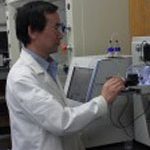
- Name: Jason Q. Pilarski, Ph.D.
- Institution: Idaho State University
- Department: Biological Sciences and Dental Sciences
- Phone: 928-380-4567
- Email: pilajaso@isu.edu
Summary: My laboratory is interested in how individual neurons and neural circuits produce maintain and modulate spontaneous rhythmic electrical activity in the brain and how this early activity is transformed into functional neural circuits. Spontaneous rhythms are important central nervous system phenomena that underlie repetitive motor behaviors such as locomotion, chewing, and breathing to name only a few. The mechanisms involved in this type of neural activity include the actions of individual cells and also the nature of cell-to-cell connectivity that can involve many hundreds of neurons. We study these neural networks by exploring neural activity, anatomy, synaptic neurophysiology, biochemistry and pharmacology using a live brain preparations from avian embryos. This brain preparation produces spontaneous neural activity even when isolated from the rest of the nervous system. Specifically, my laboratory is interested in brainstem circuits that underlie the ability to regulate and control breathing patterns. Breathing is both an amazingly regular and consistent, repetitive motor behavior (i.e., during an 80 year lifespan we can produce billions of breathing cycles), yet breathing is also a behavior that is highly modulated and plastic. For example, breathing is altered in a breath-by-breath manner during speaking, swallowing, coughing, and exercise. The breathing circuit is also modified during development, and my laboratory’s main focus is to understand both the normal and pathological development of breathing circuits during early life. Recently, we showed that brainstem breathing circuits are susceptible to pathological alterations during critical periods of development, which may help explain some medical problems experienced by newborns, such as obstructive apnea and sudden infant death syndrome.
Minimum classes: Any introductory science classes; biology, physics, chemistry preferred
Projects:
1. To isolate the specific neural circuit in the brainstem that is responsible for spontaneous breathing in birds. This circuit is completely undescribed. It is important because birds are vertebrate animals that breath just like us, yet they develop in a way (via the external egg) that allows for manipulation and experimentation that is nearly impossible in humans or even other mammals. This would be the first step in developing a model of developmental neural plasticity that is critical for understanding how neural circuits change in early life, especially when subject to altered neurochemical environments. For this work, we employ electrical recordings from live neurons and entire neural circuits using glass electrodes, amplifiers, and audiovisual equipment. This work also involves microsurgical skills, anatomy, statistics and understanding of the central nervous system environments.
2. To understand the neurochemical basis for breathing rhythm(s) in birds. In mammals, the basic circuit is unique compared to the rest of the animal kingdom and also not well understood. If we could understand the basic neurochemical environment in other “simpler” animals we could understand ourselves better. For these experiments, electrical recording equipment will be used (see also project #1) and pharmacological concepts will also be employed. The student will gain a thorough understanding of chemical communication (i.e., synaptic transmission) in the central nervous system.
3. To understand the role of homeostatic plasticity in early breathing circuits. Homeostatic plasticity is the employment of mechanisms that act to stabilize the activity of a neuron or neuronal circuit around some set-point value. Homeostatic plasticity is presumably an important phenomenon that ensures stabilization of breathing rhythms for regulating the internal electrochemical environment. However, little is known about these mechanisms during early development when the embryo and it’s environment is rapidly changing. The student will gain a thorough understanding of the brainstem and mechanisms of short and long term plasticity.



